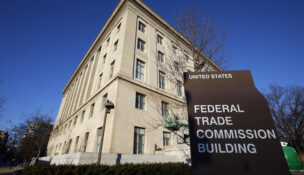Inventors languish in patent purgatory
By: Jack Zemlicka, [email protected]//April 28, 2011//
Joe Dalum’s frustration level is rising with the price of gas.
The owner of Waukesha-based Odyne Systems LLC invented a fuel-saving hybrid system for heavy duty trucks, applied for a patent four years ago and still has not heard back from the United States Patent and Trademark Office. The plug-in battery system, for trucks weighing more than 14,000 pounds, provides electrical power to operate attached equipment on job sites without running the truck engine.
Dalum still can sell his system, but a patent would make it easier to attract the investors he needs to push his system nationally or even globally.
A government program set to launch May 4 would have given Dalum the opportunity to expedite the process, but federal budget cuts postponed the program and left him waiting.
“That allows the competition to arise,” he said, “because we don’t have grounds to fully launch the technology until we have a patent in place.”
In 2009, Odyne partnered with Waukesha-based Utility Equipment Leasing Corp., which rents utility trucks, and manufacturer and distributor DUECO, Waukesha, to promote and use the hybrid system.
The idea is innovative at the moment, but Dalum said he worries the longer his patent lingers, the closer the competition will get to developing similar technology.
“It’s why we filed for a patent, because we believe it’s unique,” he said. “It would be great to be able to protect it.”
The patent delay is linked to a backlog of about 700,000 patent applications. The federal government is trying to reduce the backlog, partially through pilot programs such as one that would let applicants pay $4,000 to guarantee a response within one year.
The normal patent application costs between $500 and $1,000, and the process typically takes 18 months to two years.
But on April 21, David Kappos, director of the trademark office, announced the program would be postponed indefinitely as part of federal budget cuts.
Dalum said he was going to re-file his application through the program.
“Personally, I don’t understand why in this environment the government isn’t interested in moving the economy along with innovation,” he said. “It seems to run counter to the goals of the country.”
Dalum, who said his hybrid systems sell for between $45,000 and $222,000, said the pricier application would have been a good investment.
An expedited patent process would be an alluring option for companies trying to get a foothold in their fields, said Dalum’s lawyer Joe Ziebert. The Foley & Lardner LLP attorney out of Milwaukee estimated that about half of his small-business clients had an interest in the priority patent program.
Patent lawyer Keith Baxter also had client interest in the program.
“The patents I’m getting are taking three to four years to get through,” said Baxter, of Boyle Fredrickson SC, Milwaukee. “I think people had optimism with the new program but are now kind of shell shocked again.”
The clients who would have benefitted most from the program, he said, are those with inventions based on technology that is evolving faster than the trademark office can issue patents.
“If you have a weak patent for four years,” Baxter said, “you don’t know whether you still want to have that patent when four years can be the life of the technology.”
But patent lawyer Terri Flynn questioned how much initial interest the program would have generated, given the cost.
“I hadn’t seen a lot of people in fast-turnaround mode,” said Flynn, of Quarles & Brady LLP, Milwaukee. “Unless there was an infringement issue, I think most people would not be willing to pay the extra $4,000.”
But after four years of waiting, Dalum said, he would have paid. He said as new technology develops, there is a risk his hybrid system has a limited shelf life unless he can protect it.
“If you have a patent established, that is a barrier to companies who won’t spend the resources to design around it,” he said. “Even though we have the rights to the technology, companies are more likely to take the risk of infringement because it might not be infringement.”
• First-Action Interview Pilot Program: enables applicants to conduct an interview with examiners before a First Office Action is prepared. Any request for the pilot program must have been filed before April 1.
• Green Technology Pilot Program: allows applicants to accelerate the examination of applications pertaining to green technologies. If granted, the application will be advanced out of turn (accorded special status) for examination. Deadline is Dec. 31
• Ombudsman Pilot Program: provides a representative who will call applicants experiencing problems during processing within one day for assistance in resolving the issue. The representative provides assistance if it is legitimately believed examination has stalled and the normal channels have been ineffective.
• Patent Application Backlog Reduction Stimulus Plan: a small- or large-entity inventor who has more than one pending, unexamined application may abandon one application in exchange for another application being advanced out of turn. Deadline is Dec. 31
• Patent Prosecution Highway Pilot Program: allows participating patent offices in different countries to benefit from work previously done by another country’s patent office, with the goal of reducing examination workload. When an applicant obtains a favorable examination in an office of first filing, the applicant can request other participating countries accelerate the examination of the corresponding claims.
• Peer Review Pilot Program: an Internet-based review process in which the public is allowed to review volunteered, published patent applications and submit technical references and comments on what they believe to be the best prior art to consider during the examination. Patent examiners can then use (and supplement) the submitted prior art to evaluate patentability of an application during the examination process. The program covers computer-related inventions, biotechnology, bioinformatics, telecommunications and speech recognition applications. Runs through Sept. 30
Source: Dolan Media Newswire
Legal News
- FTC bans non-competes
- Gov. Evers seeks applicants for Dane County Circuit Court
- Milwaukee man charged in dismemberment death pleads not guilty
- Democratic-led states lead ban on the book ban
- UW Madison Professor: America’s child care crisis is holding back moms without college degrees
- History made in Trump New York trial opening statements
- Prosecutor won’t bring charges against Wisconsin lawmaker over fundraising scheme
- Republican Wisconsin Senate candidate says he doesn’t oppose elderly people voting
- Vice President Harris to reveal final rules mandating minimum standards for nursing home staffing
- Election workers fear threats to their safety as November nears
- Former law enforcement praise state’s response brief in Steven Avery case
- Eric Toney announces re-election bid for Fond du Lac County District Attorney
WLJ People
- Power 30 Personal Injury Attorneys – Russell Nicolet
- Power 30 Personal Injury Attorneys – Benjamin Nicolet
- Power 30 Personal Injury Attorneys – Dustin T. Woehl
- Power 30 Personal Injury Attorneys – Katherine Metzger
- Power 30 Personal Injury Attorneys – Joseph Ryan
- Power 30 Personal Injury Attorneys – James M. Ryan
- Power 30 Personal Injury Attorneys – Dana Wachs
- Power 30 Personal Injury Attorneys – Mark L. Thomsen
- Power 30 Personal Injury Attorneys – Matthew Lein
- Power 30 Personal Injury Attorneys – Jeffrey A. Pitman
- Power 30 Personal Injury Attorneys – William Pemberton
- Power 30 Personal Injury Attorneys – Howard S. Sicula











